Sometime in 2018, my friend, Rob Kent, downloaded an Android app that would help him record analogue exposure information. The app would let you enter the aperture, shutter speed, ISO and a subject so you could refer to it later. He tried to use this app during a couple of our of regular lunchtime photowalks, but it was a pain to use. The app wasn’t very user-friendly, it never “remembered” any of the settings from previous entries requiring all exposure data to be re-entered for each shot. This meant that recording a shot took way longer than necessary and, in my view, put you off using it. At the time, I was using a pen-and-paper approach to record my shots and was finding that to be equally slow and cumbersome. After trying the above app myself I thought: “I can do better than this”.
At this point, I should point out that I’ve been making a living writing software for over 30 years, so my exclamation wasn’t pure hubris. I also had a deadline as I had a holiday coming up where I was planning to shoot a lot of film, so I’d be able to test (or “dog food”) my own software. Plus, it was an excuse to learn a new programming language and write a mobile app. Thus, Analog Memo was born.
My Goals
I had several goals in mind from the outset. The first was to make it as easy as possible to accurately record a shot with minimal typing. If it was fiddly to enter exposure data, I just knew I wasn’t going to use it and nor would anyone else for that matter.
Also, if it was easy to miss-enter data then that would put me and other people off too. So, I wanted to make it near impossible to enter nonsense data, like mismatching lenses to cameras or entering exposure details that were out of range for the equipment you were currently using. The first part of this goal was met by the app “remembering” the previous values you entered, by using drop-downs to select things like film types, cameras and lenses and by using sliders to enter exposure data like shutter speed, aperture and focal length (zoom lens shooters, I’ve got you covered!).
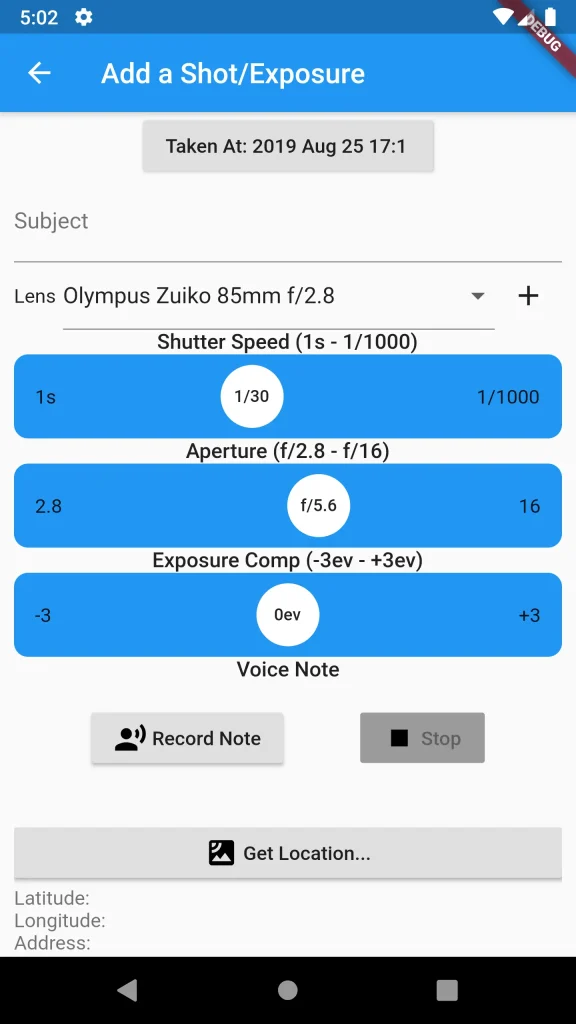
The accuracy part of the goal was met by recording information about gear. For cameras, this means recording things like shutter speed range and mount type; for lenses, aperture range and mount type (and zoom range). A happy side effect of recording your gear into the app is that it also becomes an asset manager, helping you keep track of all your toys.
My second goal was that the app should be able to keep track of multiple rolls of film, simultaneously. Like a lot of analogue shooters, I have a few cameras on the go at the same time and remembering where I’m up to with all of them is a bit of a chore. This goal was easy to achieve, it’s just a user interface and data issue and was easy to implement.
My final goal was to write the app with the wider analogue community in mind and to make it free to use. My aim was to make the app as useful and as accessible to as many analogue photographers as possible as well as putting something back into the analogue community. Consequently, Analog Memo will always be free of charge and be free of adverts. You also don’t need to log into services nor enter any of your personal info. You can, optionally, give the app permission to use your GPS, if you’d like to record where a shot was taken; and permission to use your microphone and storage, if you’d like to record a voice memo with each shot.
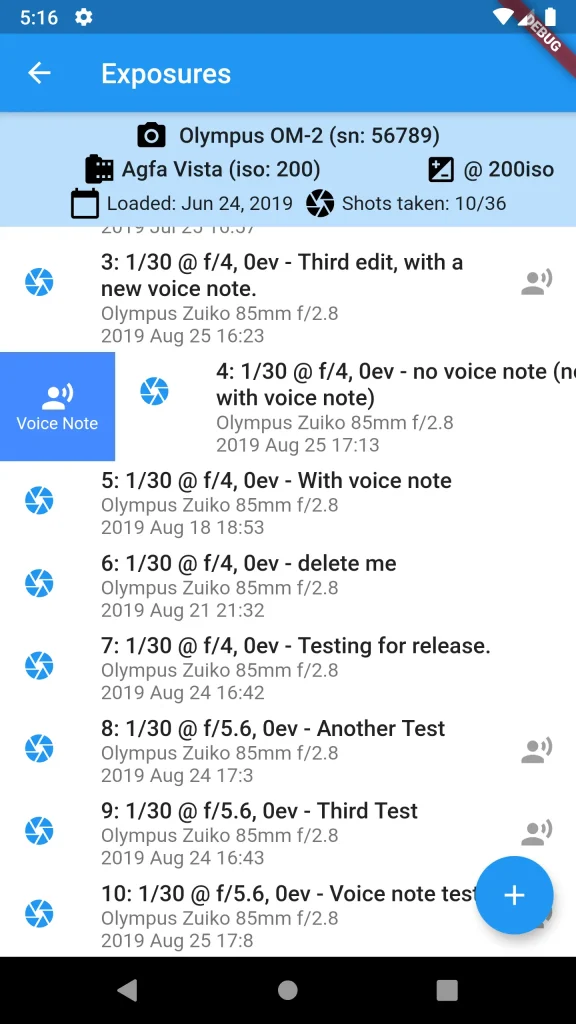
Does it work?
Version 1.0 of Analog Memo met some of my original design goals, it was easy to enter shot data but getting the app up and running needed some effort. The app needed some information about your equipment, upfront, before you could start recording exposure data and it wasn’t that obvious how to do this. After using the app for a while, it became clear to me that the app should revolve around the films the user had on the go and that the user should be able to enter data about their gear as and when it was required. After making these changes the app, now at version 1.7, was much more focused and easier to use. The current version, 1.9, saw the addition of voice notes.
There are a couple of reasons why Analog Memo asks you about your equipment. Firstly, it’s to help keep your data accurate – no impossible camera and lens combinations and no shots recorded with an aperture of f/1.0 on an f/2.8 lens. The second reason is speed. Once a piece of equipment has been recorded in Analog Memo it can, from then on, be picked from a list; you’ll never need to enter that info again and it will always be consistent. Over time, Analog Memo should become quicker to use as more of your gear is recorded. There is a third reason which I’ll explain below.
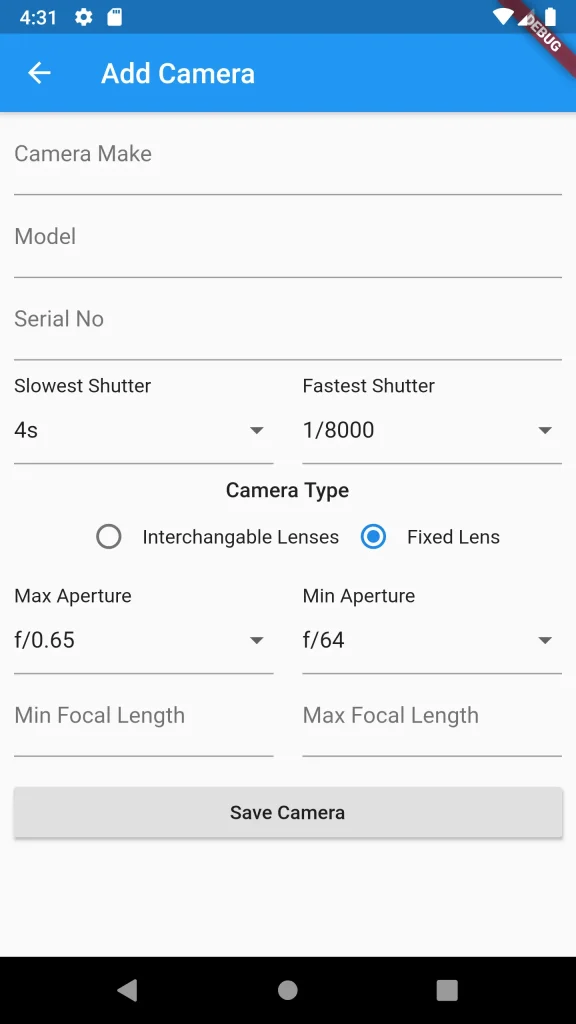
Conclusion
Is it useable and available now? Yes, and Yes. I’ve been using it myself for months now adding new features and fixing bugs as I find them. You can download it from the Google Play Store. I also have plans for an iOS version, I just need to get my hands on an iPhone to make that happen (hint, hint Rob!).
Is it finished? Nope, there are always more things to do like improve its internals and add more features. The latter is where you come in. What would you like to see in an app like this? I have plenty of ideas for new features, like a built-in light meter that pre-populates exposure data, for example. And, I’d also like to find a way of syncing the data collected by Analog Memo to your computer so that it works with Rob Kent’s “NameThatLens” application. NameThatLens updates the EXIF data stored in images files (either from scanned negatives or shots taken with a “classic” lens) to include exposure, lens and camera information; this is the other reason why Analog Memo records info about your gear (gear could also be added to NameThatLens and synced back to Analog Memo). But if you have any ideas for additional features then I’d love to hear from you.
If you’re interested in learning more about Analog Memo, there’s a complete user guide for it which is available here. If you have any other questions, you get hold of me via Twitter using the @AnalogMemo handle. I’ll also be at the Photography show on Saturday the 14th of March, if you’d like to chat about Analog Memo, see it in action or anything else.
Otherwise, you can download Analog Memo, for free, here.
Cheers!
Share this post:
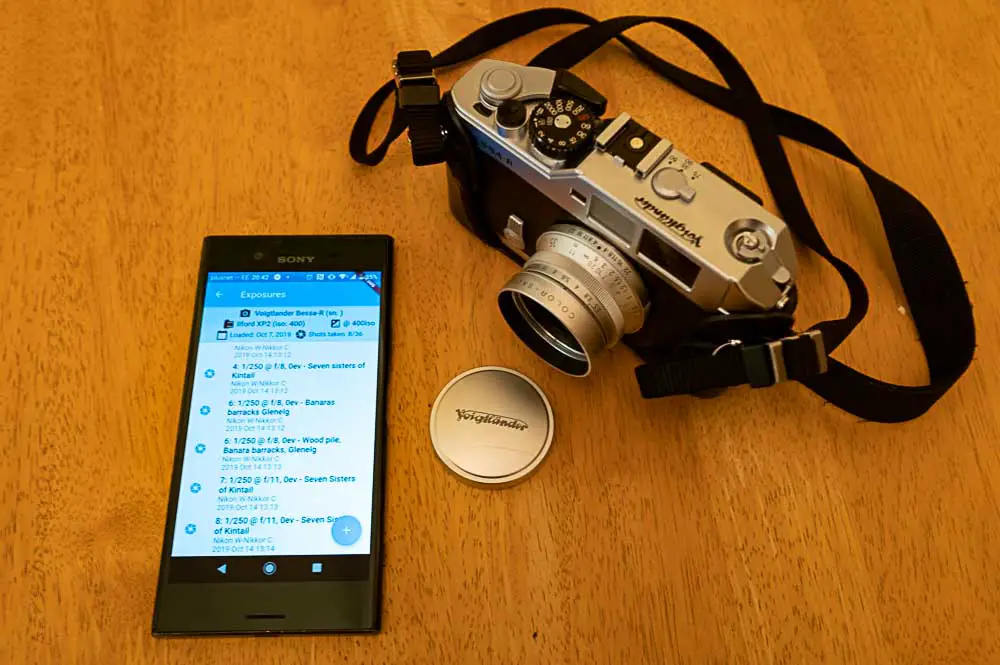


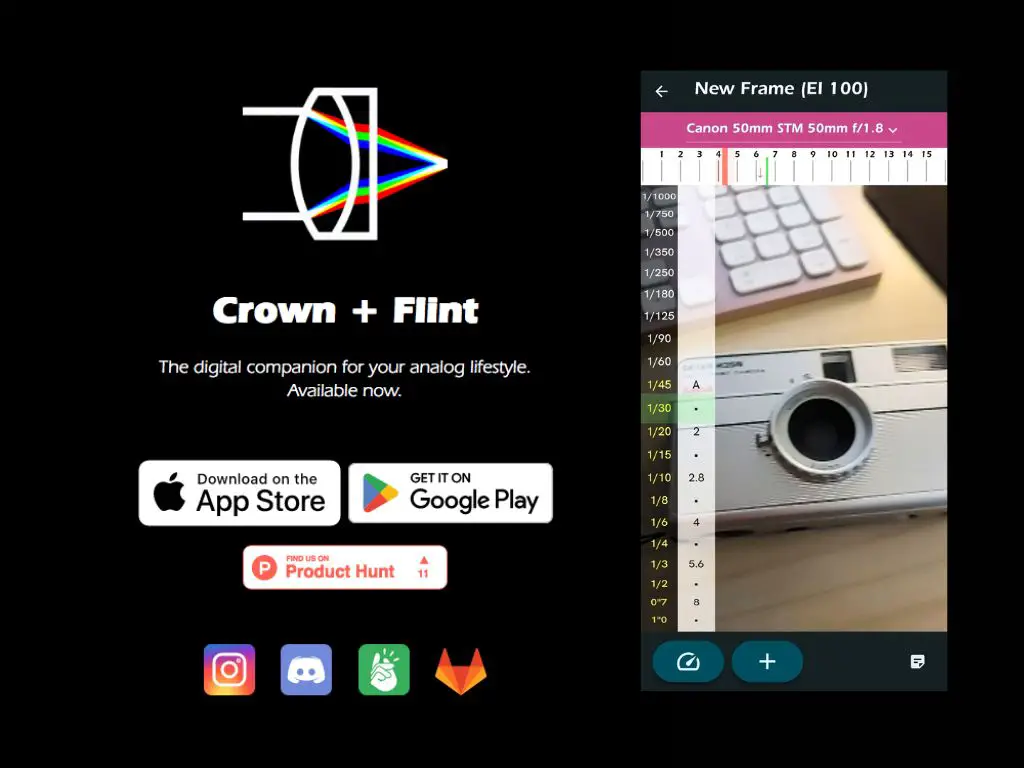
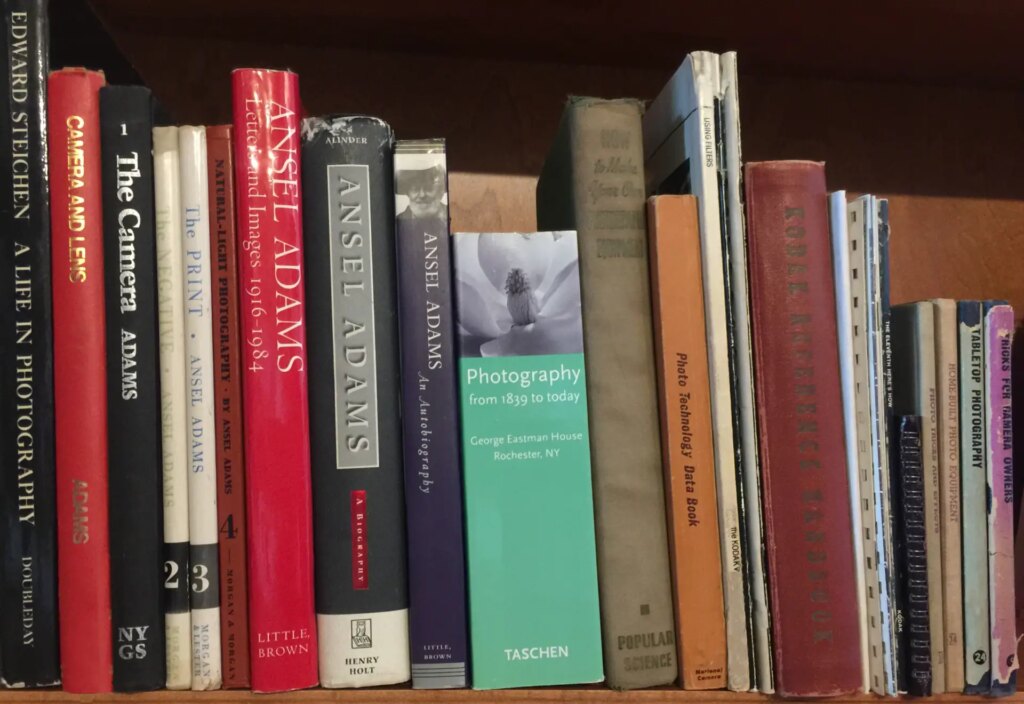




Comments
Faraz on Analog Memo – Creating a Digital Notebook App for Android – By Barry Carr
Comment posted: 09/03/2020
Comment posted: 09/03/2020
Duncan G on Analog Memo – Creating a Digital Notebook App for Android – By Barry Carr
Comment posted: 09/03/2020
Good start though...
Comment posted: 09/03/2020
Comment posted: 09/03/2020
Comment posted: 09/03/2020
Christof Rampitsch on Analog Memo – Creating a Digital Notebook App for Android – By Barry Carr
Comment posted: 09/03/2020
Excellent work and thanks for making this so easily available! A couple of things:
1. I often use filters and the /- EV setting works for some of them (red, yellow and polarizer) but not for ND, where I need typically up to 6 extra stops. It's not a big thing, but entering "Filter" would be nice? Or too much fiddling/typing?
2. I like to write a title for my films, especially if I am going on a trip where I will have multiple rolls of the same film... how does the app deal with this? I have not yet used AM in this situation, and I am not sure how I will do it Perhaps just write a date on the film in ink and match the date with AM information later?. I guess the voice note will solve these issues, and having said all of this I suppose that entering too much info would just be a disincentive to use it!
3. An automatic text-fill suggestion on the "scene" field would be nice as I often (usually) shoot the scene more than once.
But already really good! And safe to ignore my suggestions and still have a really great App.
Chris.
Comment posted: 09/03/2020
Comment posted: 09/03/2020
Comment posted: 09/03/2020
Terry B on Analog Memo – Creating a Digital Notebook App for Android – By Barry Carr
Comment posted: 09/03/2020
Being a somewhat lazy guy, this would be an absolute killer app if it could include speech to text.
Would it be feasible to down the data to a sheet that could be stored with the negs?
Comment posted: 09/03/2020
Nigel Haycock on Analog Memo – Creating a Digital Notebook App for Android – By Barry Carr
Comment posted: 09/03/2020
Thank you so much for creating this and sharing; just downloaded it and looking forward to it filling some gaps in my process - looks great. As Duncan says above non standard shutter speeds would be a help as the current camera I have loaded right now (and so the one I have added to the app first) has a max shutter speed of 1/400 which is not represented.
Not a complaint just adding my plus one to that feature being added but also appreciate you are not doing this for profit so appreciating it for what it is too :)
Comment posted: 09/03/2020
Geof Abruzzi on Analog Memo – Creating a Digital Notebook App for Android – By Barry Carr
Comment posted: 09/03/2020
Comment posted: 09/03/2020
Nigel Haycock on Analog Memo – Creating a Digital Notebook App for Android – By Barry Carr
Comment posted: 09/03/2020
I have added an number of cameras and lenses to the app and so far I like it very much - looking forward to using it in the field.
Thank you so much!
Comment posted: 09/03/2020
Comment posted: 09/03/2020
Comment posted: 09/03/2020
Comment posted: 09/03/2020
Comment posted: 09/03/2020
Comment posted: 09/03/2020
Comment posted: 09/03/2020
Comment posted: 09/03/2020
Comment posted: 09/03/2020
Comment posted: 09/03/2020
toks on Analog Memo – Creating a Digital Notebook App for Android – By Barry Carr
Comment posted: 09/03/2020
Comment posted: 09/03/2020
Stephen Malagodi on Analog Memo – Creating a Digital Notebook App for Android – By Barry Carr
Comment posted: 09/03/2020
I’ve been using a simple google form for this, and yes, it’s clunky. Useful but clunky.
One nice thing about it, that you didn’t mention, is that with a google form, the data is immediately uploaded to a google drive spreadsheet, so it’s already available on your desktop when you get there.
Would be a nice feature to add, if it isn’t there already.
Waiting on an iOS version.
Comment posted: 09/03/2020
Marc Wick on Analog Memo – Creating a Digital Notebook App for Android – By Barry Carr
Comment posted: 09/03/2020
Good luck for your App
cheers
Marc
Comment posted: 09/03/2020
Marcin Bukowski on Analog Memo – Creating a Digital Notebook App for Android – By Barry Carr
Comment posted: 10/03/2020
Comment posted: 10/03/2020
Andrew Craig on Analog Memo – Creating a Digital Notebook App for Android – By Barry Carr
Comment posted: 10/03/2020
Nothing else I can add to the many suggestions above, and it looks like you will be busy for a while. I have already entered my film kit and - for inventory purposes - will try entering my digital kit too (also for when legacy lenses cross over).
Comment posted: 10/03/2020
Mike Hannon on Analog Memo – Creating a Digital Notebook App for Android – By Barry Carr
Comment posted: 10/03/2020
Many of these issues have beem discussed on Photrio in relation to EXIF Notes, a similar and more fully featured (through a lengthy process of feedback and updates) app. All the info a photographer may require has probably been mentioned in that years old thread
https://www.photrio.com/forum/threads/new-app-for-making-exif-notes.137618/
But I do prefer your horizontal sliders - just need more increments!
Comment posted: 10/03/2020
Aleksander Warski on Analog Memo – Creating a Digital Notebook App for Android – By Barry Carr
Comment posted: 10/03/2020
Instant feedback from me:
1. I love voice notes, would love text notes too. This would allow to add some notes post developing.
2. Sometimes I just dont remember settings - today I made some shots with Phone left in the car, but i need to add them anyways. I would prefer blank fields rather than defaults (4s)
Do not print on screen any value when left blank.
3. Add a field with a number of film to track it easily in the archive.
Hope those make sense. I believe there will be more.
Comment posted: 10/03/2020
Aleksander Warski on Analog Memo – Creating a Digital Notebook App for Android – By Barry Carr
Comment posted: 10/03/2020
4. Film stock quantity field with autoupdate - when you shop but dont remember whats in the fridge
5. Film stock notes field
6. Notes for entire film (for summary, developing formula, further ideas)
7. Archive for films
Comment posted: 10/03/2020
Yeolde on Analog Memo – Creating a Digital Notebook App for Android – By Barry Carr
Comment posted: 10/03/2020
Then, what is the popping sliders, are you kidding? It is ANNOYING
Should be an ability to add a smartphone shot on the shot page - this is essential!
And fourth, why the sujet text is required field? You provoke to fill the zeroes into it. Eskimo is not a writers. We want to leave a shot from a smartphone camera here.
Fifth I want to log a filter in the shot, in that manner, like lens and other.
Shutter speed on a lenses? For that marginal old lens users, which have a set of odd lenses with a different shutter speeds for they odd cameras? Let they wait. On my camera leaf shutter speed set is identical on all lenses!
Anyway concept is right, keep on!
Comment posted: 10/03/2020
Chris Rusbridge on Analog Memo – Creating a Digital Notebook App for Android – By Barry Carr
Comment posted: 10/03/2020
Andrew Craig on Analog Memo – Creating a Digital Notebook App for Android – By Barry Carr
Comment posted: 11/03/2020
As it turns out, I do have a question, or idea: In an idle 15 minutes away from my kit, I entered most of my gear, thinking I could go back in and edit some, details and add serial numbers later. That seems not possible at the moment, unless I am missing something?
Is it also possible to delete items if, for example, one is sold?
There might already be a simple way of doing this that I have missed and I apologise if so. Otherwise, I can see someone like Hamish have a lot of redundant entries over time!
thanks again.
Comment posted: 11/03/2020
Comment posted: 11/03/2020
David on Analog Memo – Creating a Digital Notebook App for Android – By Barry Carr
Comment posted: 11/03/2020
The other thought I had was that perhaps you might somehow (and this is way above my knowledge base) be able to make the data importable intonAdobe Lightroom's Darkroom Notebook extension: https://exchange.adobe.com/creativecloud.details.100417.darkroom-notebook.html.
The extension hasn't been updated in a while and it seems like it's similar to the other applications you describe above. It works seemlessly in Lightroom, and it would be helpful to have all of the data Analog Memo collects in Lightroom , without having to manually enter it.
So far I absolutely love this App. It's brilliant. I have used other "note taking apps" for this purpose and end up giving up. But the user defined lists and ability to pre-populate each frame, truly sets it apart. As I said I have joined the Beta program and cannot wait for future releases! Best regards, David
Comment posted: 11/03/2020
Comment posted: 11/03/2020
Paolo on Analog Memo – Creating a Digital Notebook App for Android – By Barry Carr
Comment posted: 11/03/2020
Analog photography needs people like you!
Comment posted: 11/03/2020
Frederic Schneider on Analog Memo – Creating a Digital Notebook App for Android – By Barry Carr
Comment posted: 12/03/2020
Very nice application !
One thought : it would be interesting to delete an item (camera, lens, film, lens mount, etc) by adding a button in the Edit mode (under the Update button)
Thanks again for your work !
Frederic
Comment posted: 12/03/2020
Babak Farshchian on Analog Memo – Creating a Digital Notebook App for Android – By Barry Carr
Comment posted: 12/03/2020
Chris_K on Analog Memo – Creating a Digital Notebook App for Android – By Barry Carr
Comment posted: 13/03/2020
That is a really useful app. I started using it today and I must say it is great - pretty straightforward and certainly the fastest option for taking notes of the exposures. I've been thinking if there is/could be an option to export the data about the given roll to the external text file? This way it could be easily printed out and stored with the negatives after the development.
Thanks once again for the effort,
regards,
Chris
Frederic Schneider on Analog Memo – Creating a Digital Notebook App for Android – By Barry Carr
Comment posted: 17/03/2020
Nice app !
Could you add a delete button on the items. And if possible a sort button for the lists.
Thank you.
Frederic
Comment posted: 17/03/2020
Comment posted: 17/03/2020
Comment posted: 17/03/2020
Comment posted: 17/03/2020
Comment posted: 17/03/2020
Comment posted: 17/03/2020
Khürt Louis Williams on Analog Memo – Creating a Digital Notebook App for Android – By Barry Carr
Comment posted: 13/04/2020
Film Shots - Another Film Exif App For Android And iOS, But With A Difference - By Oleksii Novikov - 35mmc on Analog Memo – Creating a Digital Notebook App for Android – By Barry Carr
Comment posted: 06/08/2020
Stephen Meese on Analog Memo – Creating a Digital Notebook App for Android – By Barry Carr
Comment posted: 17/03/2023
Dale Kenworthy on Analog Memo – Creating a Digital Notebook App for Android – By Barry Carr
Comment posted: 29/07/2023
Using a pen and paper have been a bit hit and miss, Analog Memo may be what I'm looking for.
Dale Kenworthy on Analog Memo – Creating a Digital Notebook App for Android – By Barry Carr
Comment posted: 29/07/2023